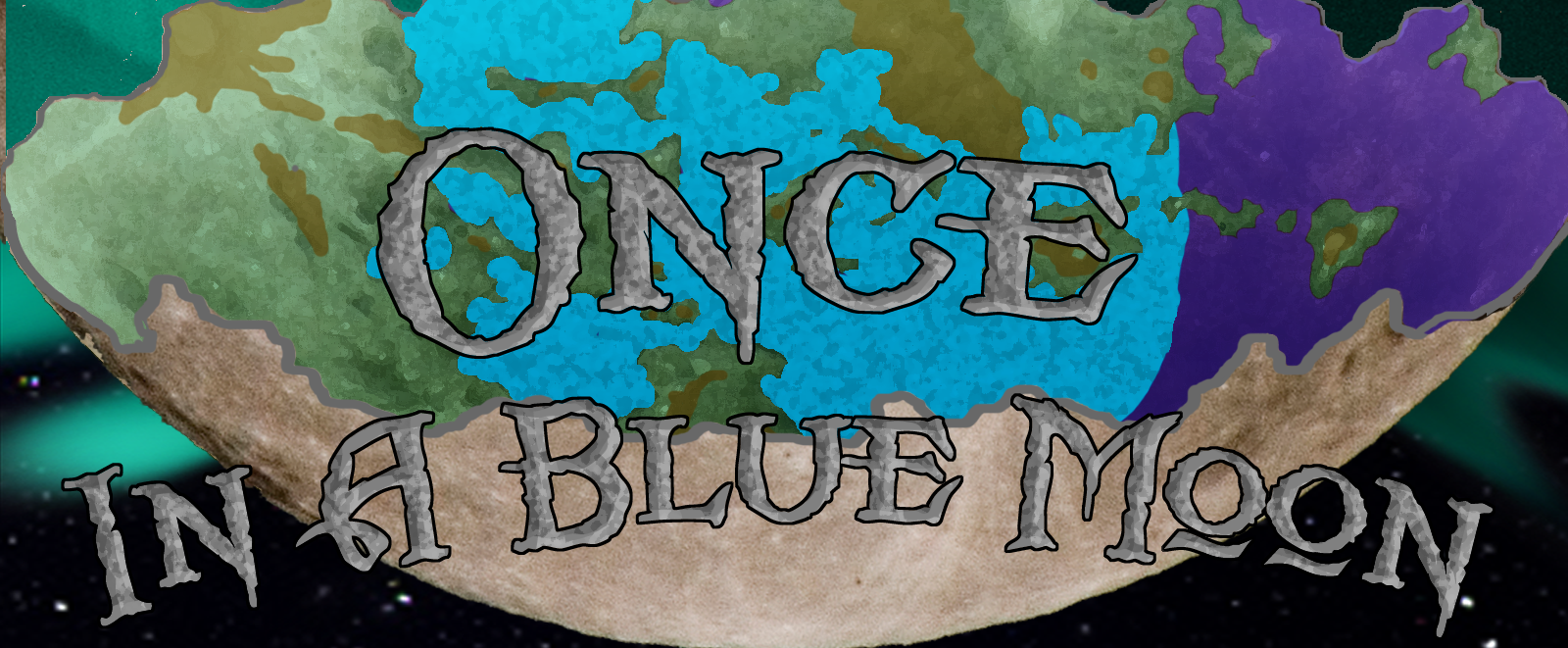
Once, In a Blue Moon: Return to the Hollow Moon
by John Calvin from Threshold Magazine issue 2Foreward by the Author:
The bizarre and beautiful setting of the Hollow Moon has intrigued me since it was first envisioned by Sharon Dornhoff in June of 1998. My intention over the next several issues of Threshold, is to re-introduce fellow Mystarans to this exquisite alien world, and to grow and expand upon the information initially bequeathed to us by Sharon.
Lunar Properties (Getting Re-Acquainted)
Everything you know about the moon is wrong… well most everything. Matera, the visible moon orbiting Mystara, looks to be a lifeless chunk of rock floating in space. Nothing could be farther from the truth. It is neither lifeless, nor solid - in fact it is more akin to a hollow crystalline sphere, the interior of which is teeming with life.
Lunar Regions
The outer surface of the moon is just as it appears from space - a cold, barren, wasteland, devoid of all life (save for the hidden Immortal city of Pandius). Those who have seen the interior of the moon, know differently. Though composed mostly of deadly crystal, there are havens in the interior of Matera that harbor an abundance of life.
Crystal bedrock
The crystal bedrock that forms Matera’s shell is nearly
indestructible (only immortal magic has any effect on it). The
crystal is cold to the touch and prolonged exposure will lead to
hypothermia and death.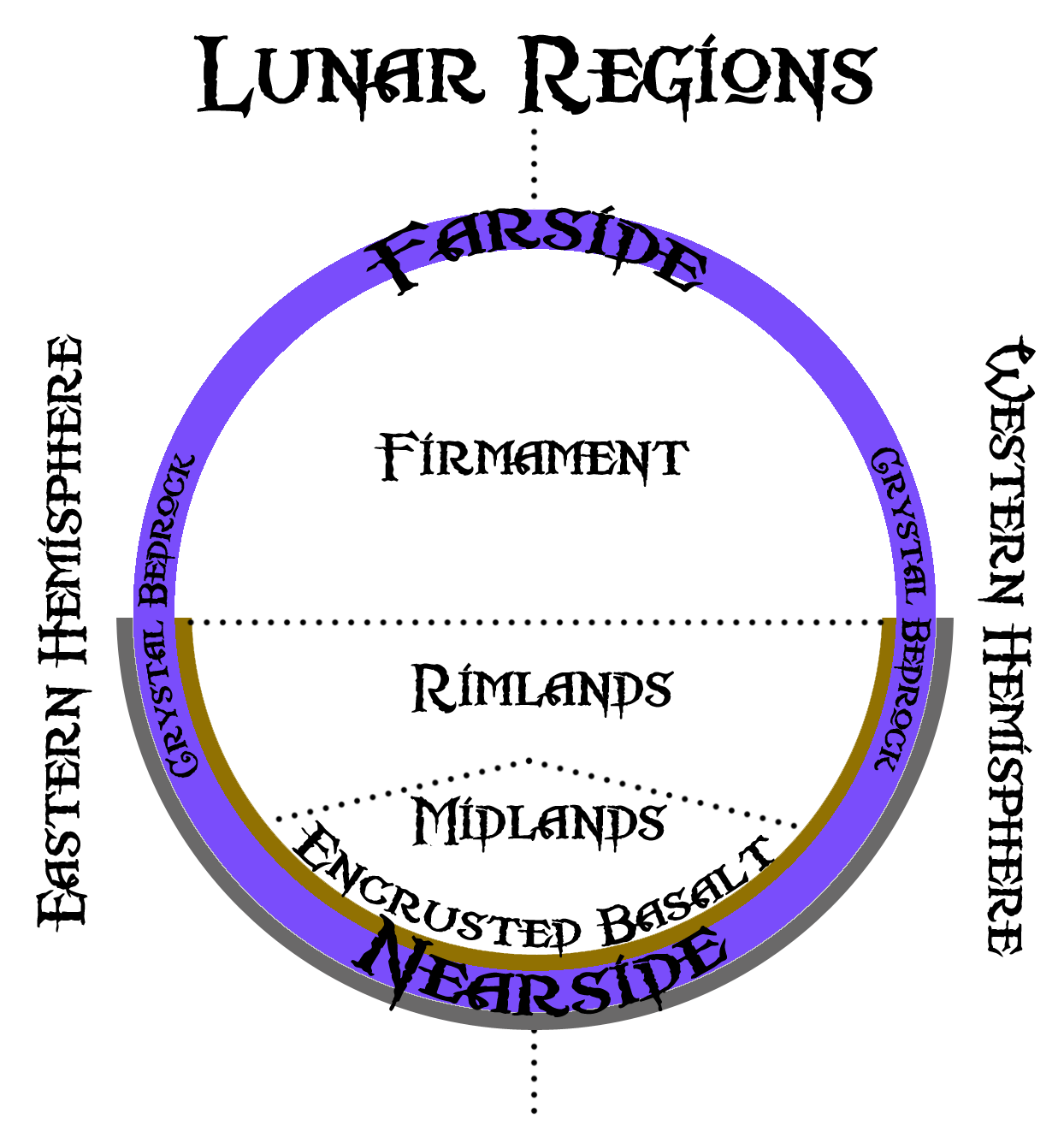
Firmament
Also referred to as the Farside, the crystal Firmament comprises the hemisphere of the moon that faces away from Mystara. Fully 80% of the Firmament is exposed crystal bedrock, with very few encrusted basalt islands to support life.
Nearside
The hemisphere of the moon that faces toward Mystara, the Nearside of Matera (both inner and outer) is covered in a layer of encrusted basalt, out of which volcanoes, mountains, hills, and plains are formed. It is only on the Nearside of Matera that life can be supported.
Crystalbarrens
Not all of the Nearside is covered in basalt. Those portions that
remain exposed crystal bedrock are called the Crystalbarrens. Most
of the oceans in the Hollow Moon cover such areas, but some remain
completely exposed, including Mare Procellarum (the largest such
area).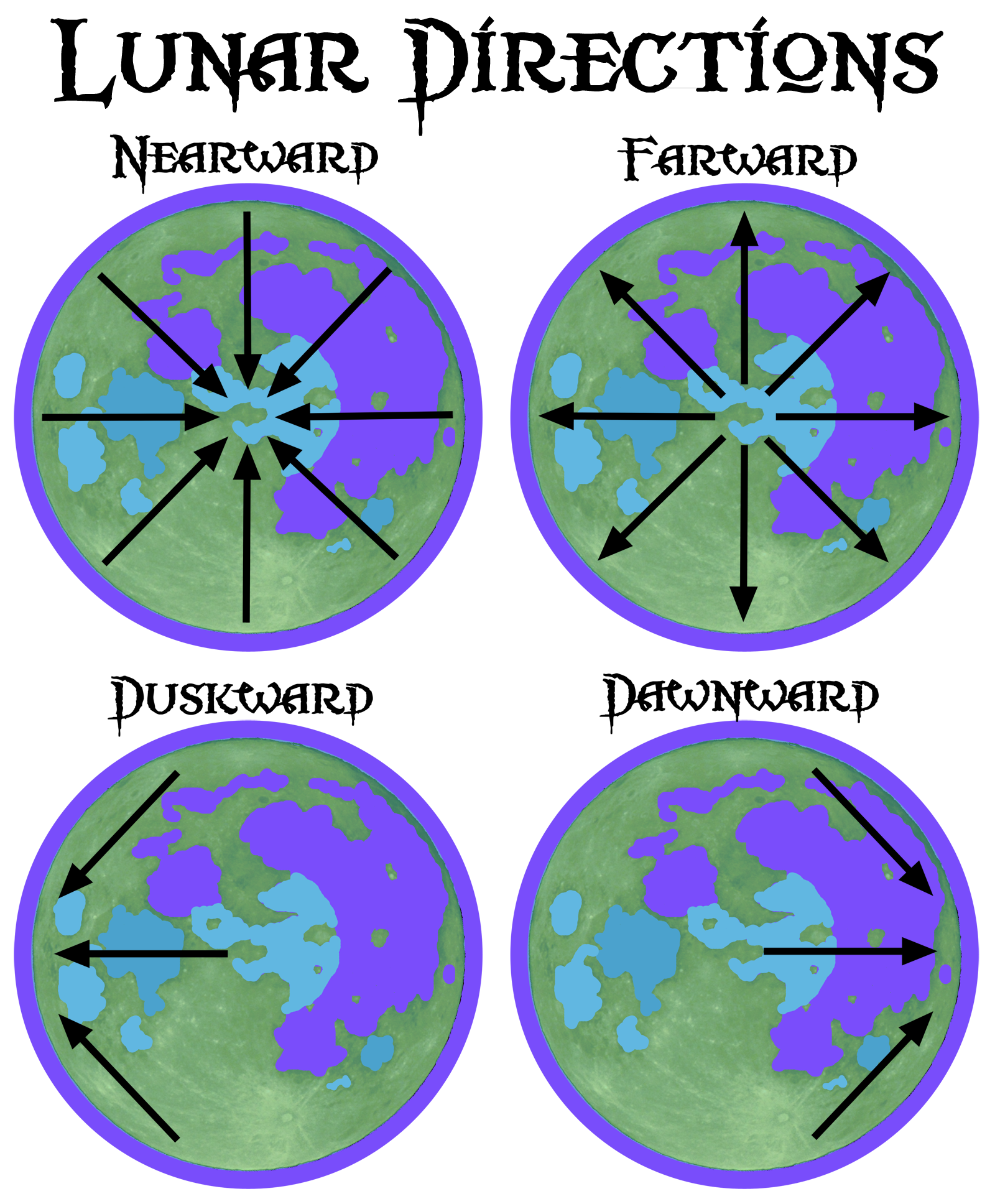
Midlands
The midlands encompass territory at the very center of the Nearside. This includes the Great Spindrift Sea, and many of the nations on or surrounding it.
Rimlands
Regions abutting the Firmament are referred to as the rimlands. This portion of Nearside circles the entire inner sphere, bordering on the Firmament.
Cardinal Directions
The terms east and west are reversed inside of the Hollow Moon, since like in the Hollow World, the inhabitants are on the inside of the moon’s shell. Likewise the directions north and south hold little meaning for Materans, who are more concerned about how close or how far one is from the center of the Nearside.
Nearward
This describes the direction one would take to travel toward the center of of the midlands. This is sometimes also referred to as Spinward - as the Great Spindrift Sea lies at the center of this region.
Farward
This is the direction one would travel when heading toward the rimlands and the Firmament.
Dawnward
This is the direction toward the location of the rising sun in the Materan west, over Mare Procellarum.
Duskward
This is the direction toward the location of the setting sun in the Materan east, over the rimlands past Mare Fecunditatis.
Lighting Inside the Hollow Moon
Life inside the Hollow Moon is dark, which is just the way the
nocturnal inhabitants like it, though it is not entirely lightless.
Some rays from the sun do make their way, albeit filtered, through
the crystalline shell that composes Matera’s bedrock. Reds,
yellows, and oranges are all filtered out by the crystal, leaving
only light in the blue and green wavelengths to pass through.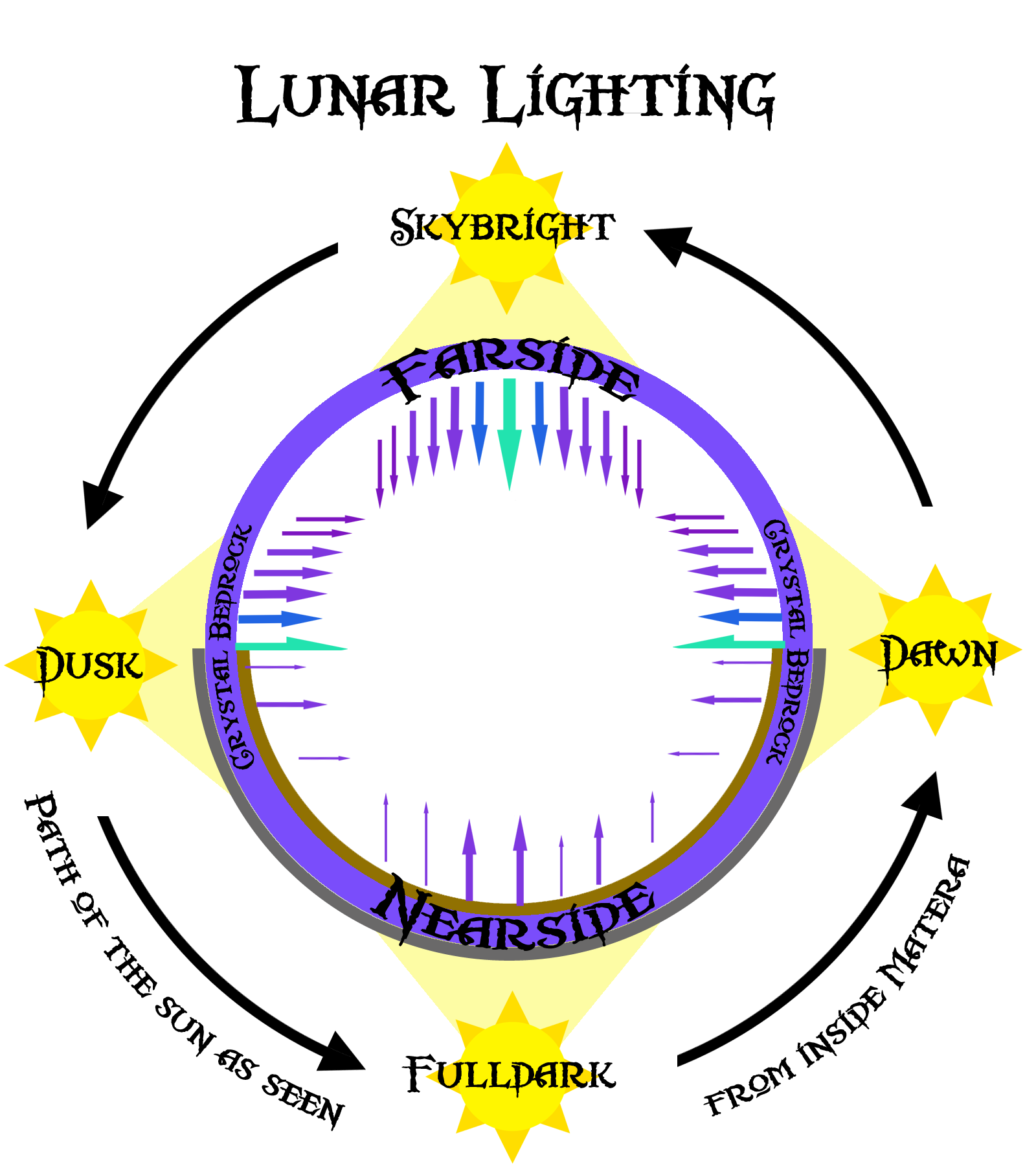
Lunar day
A lunar day, from one fulldark to the next, lasts 28 Mystaran days. During the first 14 days light increases, until finally reaching its height at skybright. During the last 14 days, light begins to diminish until the sun sets at dusk and eventually returns to fulldark.
Skybright
Midway between dawn and dusk is the brightest period of the lunar day, which Materans call skybright. The sun shines through the very center of the Firmament, producing a bluish green lighting equivalent in brightness to twilight on Mystara. This is the time of a New Moon.
Fulldark
Midway between dusk and the new dawn is fulldark. This is the darkest period of the lunar day (although still not completely lightless), during which time light shines upward through the Crystalbarrens and most of the Hollow Moon’s seas, which lay directly upon the crystal bedrock. This is the time of a Full Moon.
Colors
The crystal bedrock of the moon filters sunlight, removing most colors in the red - orange - yellow range. Thus, most colors seen in the natural light of the moon are restricted to blues and greens.
Weather and Timekeeping
The Hollow Moon year is 18 months long, and is governed by Patera’s
orbit around Mystara and its proximity with Matera. One lunar day
(28 Mystaran days long) looks much like another, and Materans would
be hard pressed to keep track of time on a larger scale if it wasn’t
for the tides. Tidal cycles, which shift from north to south during
lunar night and south to north during lunar day, mark the Materan
year.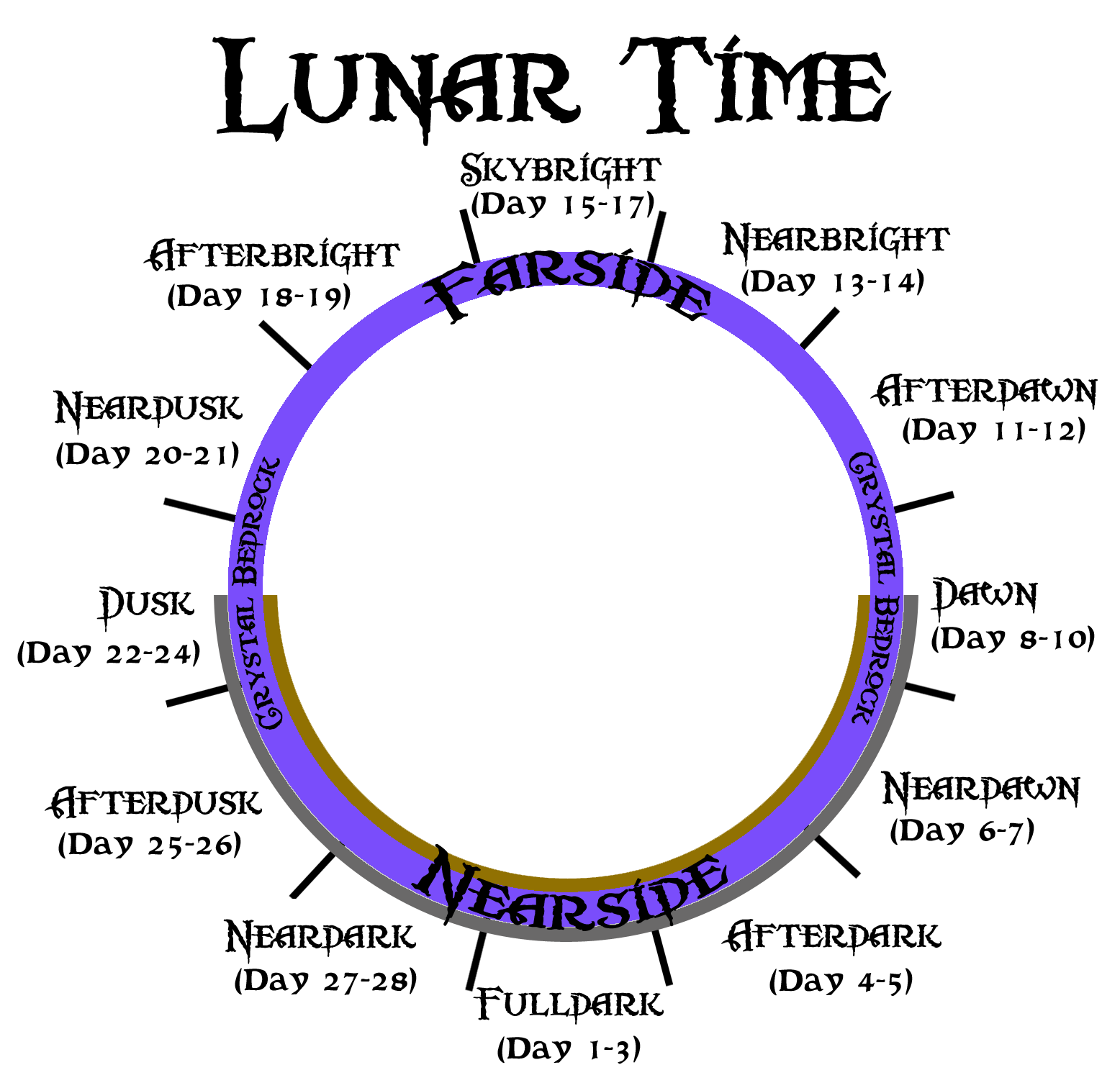
Storm Time
Weather patterns form in conjunction with the tides, as temperatures fluctuate throughout the lunar day. These storms range from mild to severe, but occur on a predictable schedule. Storms that form during dark periods tend to bring snow, while those that form during light periods bring rain, sleet, or ice storms. See Table A: The Materan Calendar for a complete listing of Storm Times.
Fire Time
Several times per year, Patera passes close enough to Matera to induce periods of intense geothermal activity. These are referred to as Fire Times by Materans, and cause volcanic eruptions throughout the Hollow Moon. Not every volcano erupts during each Fire Time. The regularity and intensity of each volcano will vary across the Hollow Moon. Some may erupt each year, while others operate on a much longer cycle (from 4 to 100 years or so).
Circle tides
These are three-and-a-half day tidal phenomenons in which all tides, winds, and cloud formations circulate around Nearside in the same spiralling pattern. During the month of Itiukkin the tides spin counterclockwise, and during Itinissatu they spin clockwise.
Doom Times
One event in the Hollow Moon can never predicted, and scares most Materans to death - a lunar eclipse. On those rare occasions when Mystara fully eclipses the moon, volcanic activity (and the utter destruction caused by it) reaches its zenith.
The Materan Calendar
The Materan Calendar was developed by philosophers from Adhuza circa BC 1800 shortly after their transportation to the Hollow Moon. Each Materan month corresponds to a single lunar day, and there are 18 such months in a Materan year.
Table A: The Materan Calendar
Immortals and the Spell of Remembrance
Just like the Hollow World, the Hollow Moon is intended to be a cultural museum and is shepherded by a council of Immortals. Undiscovered until a massive asteroid impacted Matera’s surface creating Mare Orientale and shattering the moon’s crystal bedrock, the Hollow Moon was once a dry, frigid, wasteland. Since then it has been molded by its immortal guardians (Ka, Ordana, Korotiku, and Seshay-Selene) into a dark but vibrant world capable of supporting a multitude of life.
As a cultural sink, the Hollow Moon’s purpose is to preserve those Mystaran cultures which have met with an untimely end on that planet’s surface. Unlike the Hollow World, the Hollow Moon has been designed to cater to nocturnal cultures - and because of the presence of two Time immortals on its council (Ordana and Seshay-Selene) - Hollow Moon cultures are given more leeway to grow and change over time.
The Spell of Remembrance insures that the members of a culture never forget their heritage. This won’t prevent them from being conquered by their neighbors, nor will it prevent them from using new technologies, however their culture - at its core - will not change. For example a conquered culture would always remember its roots, and given the opportunity they would rebel against their conquerors (even if treated justly) at their first chance. Stone age cultures wouldn’t balk at using bronze or iron weapons, but might reject new clothing fashions that go against their cultural grain.
The unique properties of the Spell of Remembrance give it a cyclical nature. A primitive culture may be placed in the Hollow Moon, be conquered by its neighbors, overthrow them and have a meteoric rise to power, only to be toppled by another neighbor and sink back to its primitive state. The Spell of Remembrance doesn’t prevent cultures from growing or changing over time… but it does insure that cultures will never lose those aspects which make them unique.
Mystaran Travellers
There are several ways in which a Mystaran native can reach the interior of the Hollow Moon. Discovering its existence in the first place, may prove the harder task. Most information about Matera’s interior was kept by the Nithians (and more specifically the Nepthisian sect which eventually fled to the moon) and it may be possible to tease this out of ancient scrolls and texts still hidden away in Ylaruam or Thothia.
Voidships
Voidships can traverse the vacuum of space that separates Mystara from its orbiting moon, but actually getting inside of Matera is fairly tricky. The moon’s crystal bedrock is impenetrable, but enterprising explorers may be able to enter through a naturally occurring crack in Mare Orientale, where the prehistoric asteroid impact nearly shattered the moon.
Although indestructible (at least through mortal means) magic can be used to open temporary crystal passages through the moon’s shell. Such magic was known to the Nepthisians who fled Mystara in 691 BC, as well as to their cryion allies. These passages can only be opened on the Farside’s crystal Firmament or over one of the Nearside’s Maria.
Well of the Moon
Located deep in the crevices of the Black Mountains lies the wondrous artifact known as the Well of the Moon. Although most known for its healing powers, the Well of the Moon can also be used for other means. On nights of the full moon, the Well creates a ladder of moonbeams between itself and Matera. The ladder can be scaled in a single night, and will deposit those climbing it on the edge of Mount Copernicus in the Spindrift Sea.
The Well creates a crystal passage through Mare Imbrium (along with a portion of the Spindrift Sea covering it). Individuals traversing the moonbeam ladder are not aware they are passing through the crystal bedrock of the moon, nor through the inner sea. Falling from the ladder, before reaching its destination, may be catastrophic and can deposit travelers on an outer plane (the Ethereal, Astral, or another plane of the DMs creation) or back at the Well of the Moon on Mystara where they started from (at the DM’s discretion).
Needle
The phase spiders of Chak maintain a small trading post on the surface of Matera. This trading post can be reached by using a magical obelisk (the Needle) located deep in the heart of the Davanian jungle. On nights of a full moon a magical doorway opens at the base of the Needle. Anyone stepping through is transported to the underground realm of the Chak on Matera’s surface.
In addition to the portal to Davania (and perhaps to other locations in the Mystaran solar system), the Chak base also harbors a crystal passage that leads to the aranea realm of Aran on the moon’s interior. PCs who can earn the Chak’s trust may be allowed to use this portal to journey into the Hollow Moon.
[Insert map of the Hollow Moon at 40 mph]
Timeline
Prehistory: The Desert Ghosts discover the Hollow Moon through portals to the Plane of Earth.
BC 14000: Six Ur-Carnifex tribes transported to the Hollow Moon.
BC 12500: Pteryx city of Attyx transported to the Hollow Moon. They soon colonize the Apennines.
BC 12500: Shovelface trogs placed in Marsh of Putrescence.
BC 8000: Shark-kin living along the coast of Davania placed in Mare Humorum after their culture is decimated by the kopru.
BC 7000: Longlegs trogs placed in Marsh of Putrescence.
BC 6500: Using an artifact stolen long ago from carnifex priesthood on Mystara, Demogorgon curses her people (the pteryx) to see all non-telepathic races as animals.
BC 6400: Saurolunarian Conflict begins - the pteryx begin a program of “purging” to keep the ur-carnifex population from encroaching upon pteryx civilization.
BC 5150: Cryions - Cryions are not natives of Mystara (they migrate from Matera to Mystara, but did they originate on Matera?)
BC 5100: The pteryx perform the largest ur-carnifex culling in history, nearly destroying the race. Ur-Carnifex transplanted to the Jura Peninsula by Seshay-Selene, hoping to remove them from pteryx concerns. Saurolunarian Conflict ends.
BC 5000: Pisachas moved to the Hollow Moon.
BC 4950: Spell of Remembrance cast by Seshay-Selene and the other immortals of the Hollow Moon council.
BC 3000: Hsiao placed in southern outlands forests.
BC 2850: Margasta tribes placed in the trifold isthmus between Tranquillitatis, Foecunditatis and Nectaris after being decimated in the wars between the Azcans and Oltecs.
BC 2200: Aardovai placed in the Rilles area.
BC 2000: Aran placed on Altai Scarp just before the founding of Herath.
Quarikka moved to the Hollow Moon.
BC 1800 to BC 900: Adhuzan Dominions placed in the southern Spindrift Sea and nearby mountain ranges (all containing underground thermal springs). Additions to Adhuza are made throughout the following centuries (as Adhuza rises and falls several times on Mystara).
BC 1800 - present: Goblinoids placed in southern outlands forests during the collapse of Urzud. There have been numerous placements of various goblinoid cultures into the Outlands Forests over the eons since then.
BC1650: Devil fish placed in Sinus Medii and Mare Vaporum, as their society is overrun by a strain of Taymoran vampirism.
BC 1600: Modrigswerg placed in the Caucases Mountains.
BC 1400: Schattenalfen transported to the Vesperlands
BC 800: Shaergarde hin are placed in the Hollow Moon after the fall of Shaerdon.
BC 800: Maskelyne placed in the Hollow Moon
BC 691: Albheldri colony established on Haemus Isles by Nephthisian and Albarendi immigrants.
BC 500: Nimmurian manscorpions moved to Sohktar shortly after being cursed by Ixion.
BC 500: Wallara moved to the Hollow Moon after being cursed by the Herathians. Before placing them inside Matera, the immortals do their best to restore their cultural memories.
BC 400: Pre-Imperial Pateran rakastas are placed on Fra Mauro.
BC 250: Cacklogallinia trade cities placed on the S-T Strait.
AC 311: Cynidiceans are transported to the Hollow Moon.
AC 42: Serraine gnomes travel to Hollow Moon on a rocket ship and settle the Taurus Mountains.
AC 100: Shark-kin living along the coast of Brun placed in Mare Crysium after their populations are hunted to near extinction by surface dwellers.
AC 451: Humans and bhuts from Sind are transported to the Hollow Moon and form the nation of Vedal
AC 550: Ostegos placed in Stygia region.
AC 800: Traladarans transported to Hollow Moon near Deslandres and found Toroldorsk.
AC 805: Latest pteryx culling (against the cryions) resulted in 20,000 lives lost.
AC 920: Graakhalian gnolls transported to Jansen savannas.
Nations
The following 4 nations/cultures are some of the older species moved to the Hollow Moon, and many span across the entirety of the Nearside (and in the case of the desert ghosts, the Farside as well).
Crystalbarrens of the Cryions
Arrival Date
5150 BC. The cryions migrated to Matera’s interior on their own, and have since sent colonizing expeditions back to Mystara.
On the Outer World
Cryions once lived in the frozen north of Mystara, but were nearly
driven to extinction by encroaching beastmen. Followers of
Seshay-Selene, they were given instructions by their immortal
patroness to build voidships and journey to the moon. For a long
time there were no c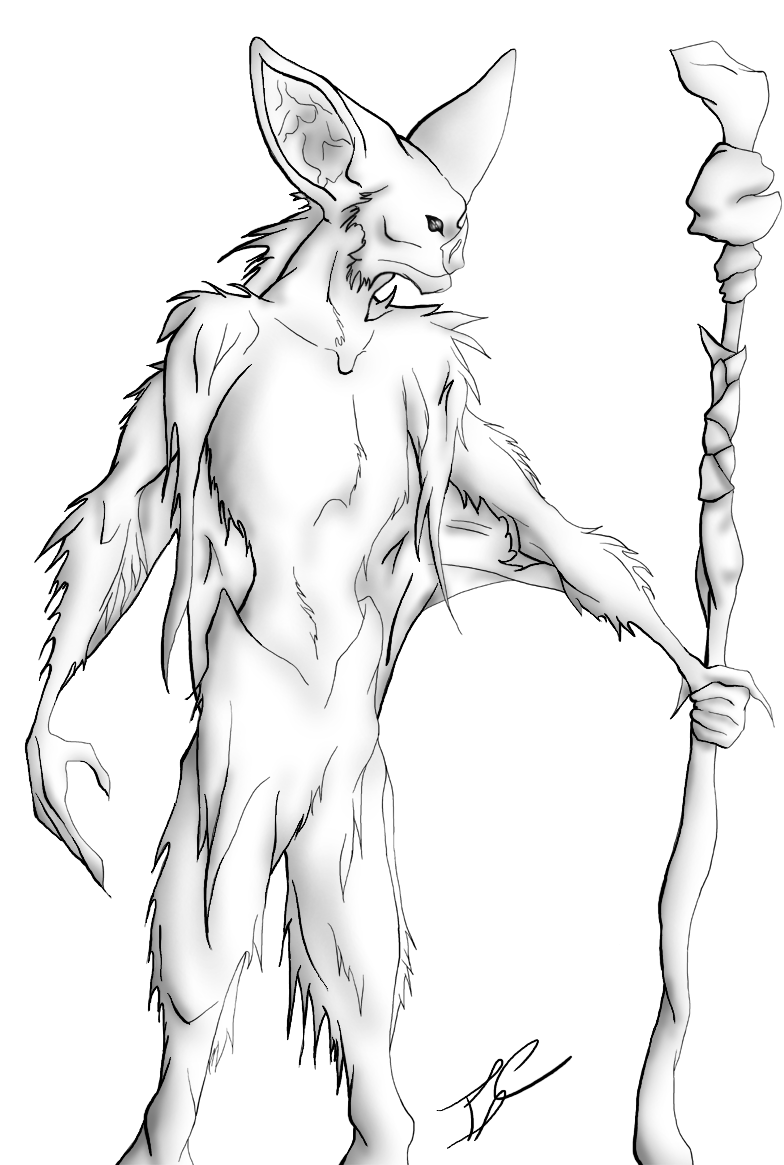 ryions
on Mystara, until the Stormspume-mandated diaspora when Seshay-Selene
once again sent a portion of her followers into space, this time to
meet the Nephthisian exodus. There the cryions and Nephthisians
switched ships, with the cryions returning to Mystara and the
Nephthisians fleeing to the interior of Matera.
ryions
on Mystara, until the Stormspume-mandated diaspora when Seshay-Selene
once again sent a portion of her followers into space, this time to
meet the Nephthisian exodus. There the cryions and Nephthisians
switched ships, with the cryions returning to Mystara and the
Nephthisians fleeing to the interior of Matera.
In the Hollow Moon
Cryions make their homes on the freezing crystalbarrens of Mare Procellarum, constantly moving their herds of thick hoofed bovines from one of the small, moss covered, basalt islands that dot its surface to the next. Their nomadic roamings bring them into contact with all of the cultures of the Spindrift Sea and the Dawnward Rimside.
Culture
Having fled to the Hollow Moon from Mystara long before the rise of Blackmoor, the cryions are one of the few races that realize they are living inside of Matera. Mnelds, small communal groups of the bat people, traverse the open crystalbarrens in double keeled outriggers designed to slide upon its surface. Few islands on crystalbarrens are large enough to support such bands and their bovine herds for long, so the mnelds must move constantly in search of fertile grazing lands.
Mount Copernicus is sacred to the cryions - it is their belief that Tchirichee the Great Stormspume (their name for the immortal Seshay-Selene), dwells here. Once every Materan year, all cryion mnelds gather at the foot of the now dead volcano in order to listen for her song. Upon arriving at Copernicus the cryion’s mnelds are dissolved and their shamans inscribe the names of births and deaths in the sacred caves. Trade is conducted, marriages are performed, and feasts and celebrations continue non-stop. This religious frenzy lasts for nearly the entire month of Itiukkin, culminating during that month’s Fire Time when new mnelds form and once again set out across the freezing crystal.
Although herding is the cryion’s primary profession, it is not the only activity they perform. Many mnelds conduct trade with their neighbors as well as performing the occasional raid against them. Because the makeup of a cryion mneld changes from year to year, their behavior can appear erratic to outsiders. The mneld traversing a particular territory may be friendly and open to trade in one year, and hostile and prone to raiding during the next, all because of its changing membership.
Fire Times
Fire Times are rarely impactful on the crystalbarrens, where there are few truly active volcanoes. Some mnelds use the chaos brought on during the Fire Times to raid neighboring nations of the Nearside, especially the troglodytes of the Marsh of Putrescence, and the folk of Adhuza.
Adventure Ideas
Embedded in the ice rimmed edge between the Great Spindrift Sea and Mare Procellarum, lies an ancient cryion outrigger dating back to the Nephthisian exodus. Bones of the Nephthisian priestesses lay where they fell, slain by an incorporeal Nithian undead that managed to sneak on board. It maintains a constant vigil over the treasures within, waiting to slay any who dare explore the ship.
A particularly war-like cryion mneld has formed and begun attacking settlements bordering the crystalbarrens of northern Procularrum, focusing especially on the troglodyte villages in the Marsh of Putrescence. Cryions and outsiders alike all fear that the savagery of this new mneld will catch the attention of the pteryx, and ussher forth another culling even more brutal than the last.
Desert ghost attacks have increased along the Carpathian Archipelago, spurred in part due to the overabundance of electrical activity during the last several Storm Times. Hidden in one of the archipelago’s long dormant volcanoes, a crazed mordrigswerg dwarf has found an ancient artifact giving her mastery over the weather. She has been using this power to direct and bolster the attacks of the local bands of desert ghosts, swooping in to reap the rewards of their plunder once the storms die down.
Crystalbarrens of the Desert Ghosts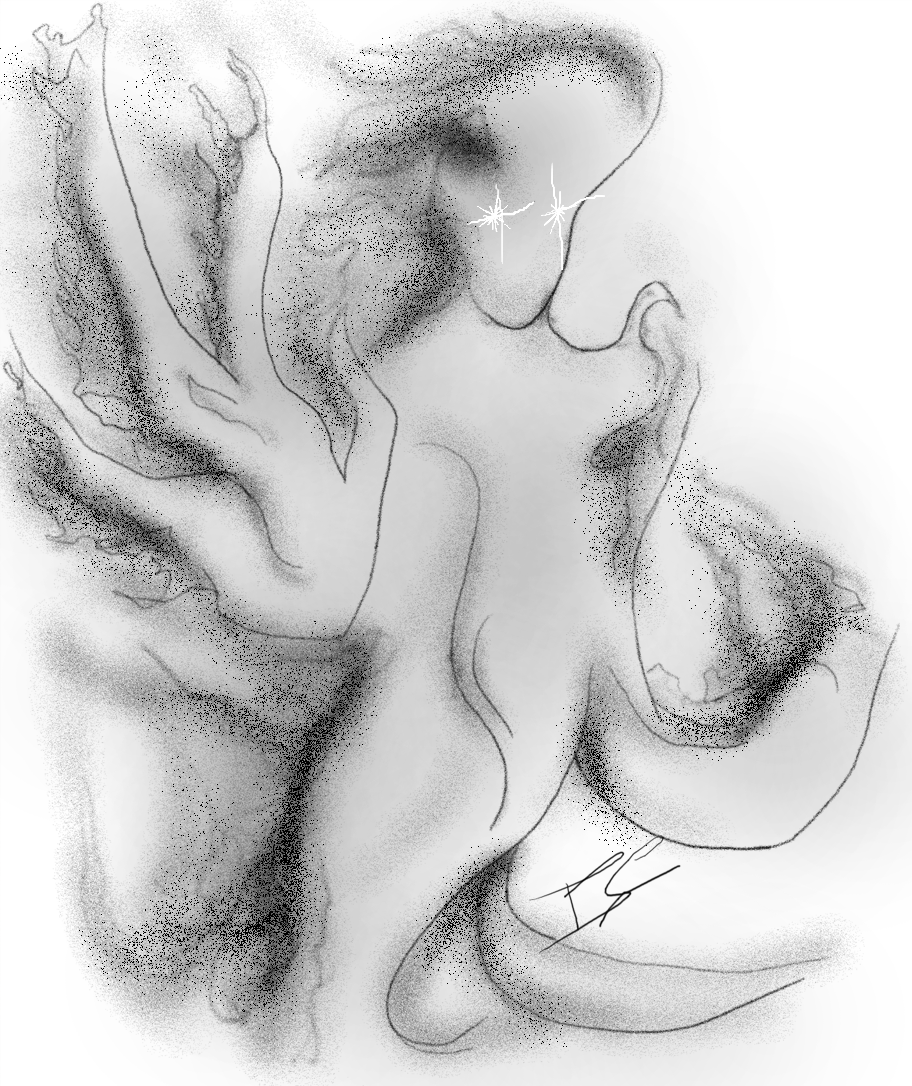
Arrival Date
The desert ghosts are natives of the Hollow Moon
On the Outer World
Since time immemorial, the Desert Ghosts have traveled to the Hollow Moon through planar gates to the Elemental Plane of Earth. When the Firmament shattered and the Immortals created the Spell of Remembrance, those portals were sealed. The Desert Ghosts have remained trapped inside the Hollow Moon ever since.
In the Hollow Moon
Desert ghosts have roamed the interior of Matera since time immemorial. The great meteor that crashed into Mare Orientale, shattering the Firmament, changed their world forever. With the crash came increased geological activity, as kinetic energy from the impact infused the moon’s crystalline bedrock. So too came heat, and storms… and deadly liquid water. Uncounted millions of desert ghosts perished during that initial impact, and over the course of the eons to come, because of Matera’s renewed life. Still, they roam Oceanus Procellarum and the trackless, untouched, wastelands of the Firmament’s cracked dome, though their vulnerability and hatred of water has made them ever vigilant.
Culture
Desert ghosts undergo two major phases during their lifecycle. Immature ghosts are little more than electrostatic balls of dust and debris. They float around the inner surface of Matera, consuming any electrical energy they can find. During this phase of their life, the desert ghosts are little more than feral creatures - their animal-like instincts driving them feed and grow with little recognition of events unfolding around them. Nursery grounds for immature ghosts are common across the interior of Mare Procellarum and the Firmament (where liquid water is scarce), but increased numbers of the creatures can always be found on the edges of most electrical storms that rage across the crystalbarrens.
Mature desert ghosts are another matter entirely, as they exhibit at the very least a rudimentary intelligence, and possibly a shared racial memory of the disaster that befell them in Matera’s ancient past. Mature ghosts hate liquid water and worked iron, and despise all creatures that make use of these items. They will attack most biological life that intrudes upon their crystalbarrens out of fear and hatred, sometimes executing intricate plots to weaken their enemies before engaging them. Cryions are one of their most hated foes, and the two races have a long history of antagonism between them.
Fire Times
Fire Times are rare upon the crystalbarrens of Procellarum, and rarer still in the freezing wastes of the Firmament. Storm Times, with the precipitation that they bring, are much more devastating to the desert ghosts, who find liquid water deadly in all of its forms. During these times the desert ghosts seek shelter wherever they can - in old volcanic tubes, rocky caves, cliffside bowles, and even abandoned shelters of the cryions and other Nearside dwellers. Most that can however, flee to furthest corners of the Farside, where weather patterns rarely form.
Adventure Ideas
Three mysterious obelisks have appeared on the open crystal barrens in the center of cryion territory. Electrical bolts arc between them, causing ion storms and drawing an inordinate number of immature desert ghosts into the area. Feeding and growing at an increased rate, the desert ghosts threaten to overrun the local cryions unless something can be done to shut down or destroy the obelisks.
Tales abound of travellers near Sinus Somniorum encountering ominous bands of desert ghosts who glare at folk from shadows at the periphery of their camps. Strangely none of these encounters has ended in violence, but traders and merchants of the area fear the worst. In fact a small band of desert ghosts has decided to make peaceful contact with the creatures of the Nearside, but have thus far been unsuccessful in their attempts to communicate.
Desert ghost attacks along the Rimlands have been increasing steadily, as nations all along the Firmament brace themselves for an impending war with the elemental creatures. Deep in the Farside, and ancient evil has awoken - a gigantic elemental horror composed of dust and lightning - and has been pursuing the desert ghosts across the Firmament, consuming them when it can and driving them from their homes to the dangers of the water filled Nearside. Only once this ancient evil has been dealt with, will life along the Rimlands return to normal.
Pisachas
Sidebar: Pisachas are a race of bestial creatures that feed on the flesh of corpses, imported into the Hollow Moon from Indian mythology by Sharon Dornhoff. Their main purpose in the setting is to oppose the machinations of Thanatos and to keep the populations of corporeal undead in check (in a world without sunlight). Though despised by many, the pisachas of the Hollow Moon differ from their real world counterparts in that they are not a wholly evil race.
Arrival Date
5000 BC. Pisachas are one of the few cultures transported to the Hollow Moon before the activation of the Spell of Remembrance.
On the Outer World
Long ago the pisachas lived in a small mountainous kingdom in the area that would later become Sind. Their need to sustain themselves on the corpses of the dead incurred them the wrath of Thanatos, who spent centuries plotting their downfall. The last vestiges of pisacha culture were moved to the Hollow Moon after their kingdom was decimated by an army of ghouls from under the mountains.
In the Hollow Moon
Pisacha culture is spread across the Hollow Moon, except in a few key areas - the Albheldri Islands, the Margasta Peninsula, and the nation of Vedal - all of which contain cultures that are fanatical about the preservation of their dead.
Culture
Although not a unified culture as such, the pisachas (or “bone people” as they are sometimes called) are spread throughout most of the livable terrain in the Hollow Moon. Despite the general revulsion felt for pisachas, they do serve an important function in the Hollow Moon - a world drenched in near constant darkness. Pisachas eat the dead, and hence have a tendency to reduce the overall number of corporeal undead inside of Matera.
Most cultures in the Hollow Moon turn a blind eye to local pisacha activities, while a few actually integrate the creatures into their funerary customs. While pisachas must survive on carrion, they are neither beastial nor savage, and will either return the bones of the deceased back to their families for burial or inter them themselves (depending on the particular Hollow Moon culture they share territory with). Amongst themselves, the pisachas maintain a network of communication from group to group, and are always well versed in the comings and goings of folk beyond their own personal boundaries.
Despite the grudging tolerance of their behavior, pisachas are still treated as pariahs - untouchables beneath the contempt of most societies. They live hidden on the outskirts of settlements or in isolated pockets of wilderness nearby, and actively try to avoid contact with the local inhabitants of their area. Graveyards and catacombs are their domain, and they will descend on a field of battle within hours of its completion, picking the field clean of corpses. Indeed, anywhere there are sick or dying individuals, the pisachas won’t be far behind.
Fire Times
Since they are distributed across the Nearside, pisachas follow the local customs with regard to Storm and Fire times. As societal outcasts, their populations remain separate from the local populace, but most follow parallel policies where safety is concerned.
Adventure Ideas
Pisachas are being found dead in the dark corners of town - sprawled out in alleyways for all to see. Though the creatures themselves would never ask for it, they are in dire need of help. A powerful band of corporeal undead has managed to take hold in the area and they are systematically hunting the pisachas down.
With the onslaught of a particularly violent Fire Times looming on the horizon, the townsfolk realize that the only thing that can save their settlement is an artifact once wielded by a local hero. The PCs will have to befriend the pisachas in the area, and convince them to reveal the hero’s final resting place, so that they can return to the town with the artifact before it is destroyed.
Fleeing the scene of a crime, a local thief sought refuge amongst the town’s population of pisacha. The PCs are tasked with bringing the thief to justice so that he might answer for his crimes. Unfortunately, the hapless criminal is mortally wounded, and the pisachas are simply waiting for him to die before serving him on a platter.
Pteryx
Sidebar: The Pteryx are one of the few Hollow Moon cultures originally detailed by Sharon Dornhoff, and as such, there is a plethora of information that can be found on the nation already in the Vaults of Pandius.
Arrival Date
12,500 BCOn the Outer World
Contemporaries of the ur-carnifex, the pteryx were at one time the preeminent species on Mystara. By the time the carnifex came on the scene, their culture was already highly advanced, both in magic and technology. Unfortunately for the pteryx, their supremacy would not last. The aggressive carnifex society quickly outpaced them, and once that happened their fate was sealed. After centuries of war, their last city, Attyx, set high in the Brasol Range of Davania, was plucked from its perch and deposited in the Hollow Moon mere hours before its impending destruction.
In the Hollow Moon
When Attyx was placed in a dormant volcano in the Pteryx Apennines, the pteryx were only the second culture to be deposited in the Hollow Moon by the immortals. Since that time their population has grown to encompass several cities throughout the Apennines, and the pteryx have become the undisputed masters of Matera. Their very name is synonymous with the word for “terror” in most other cultures in the Hollow Moon, and no one willingly travels near their sphere of influence save for their troglodyte servants.
Culture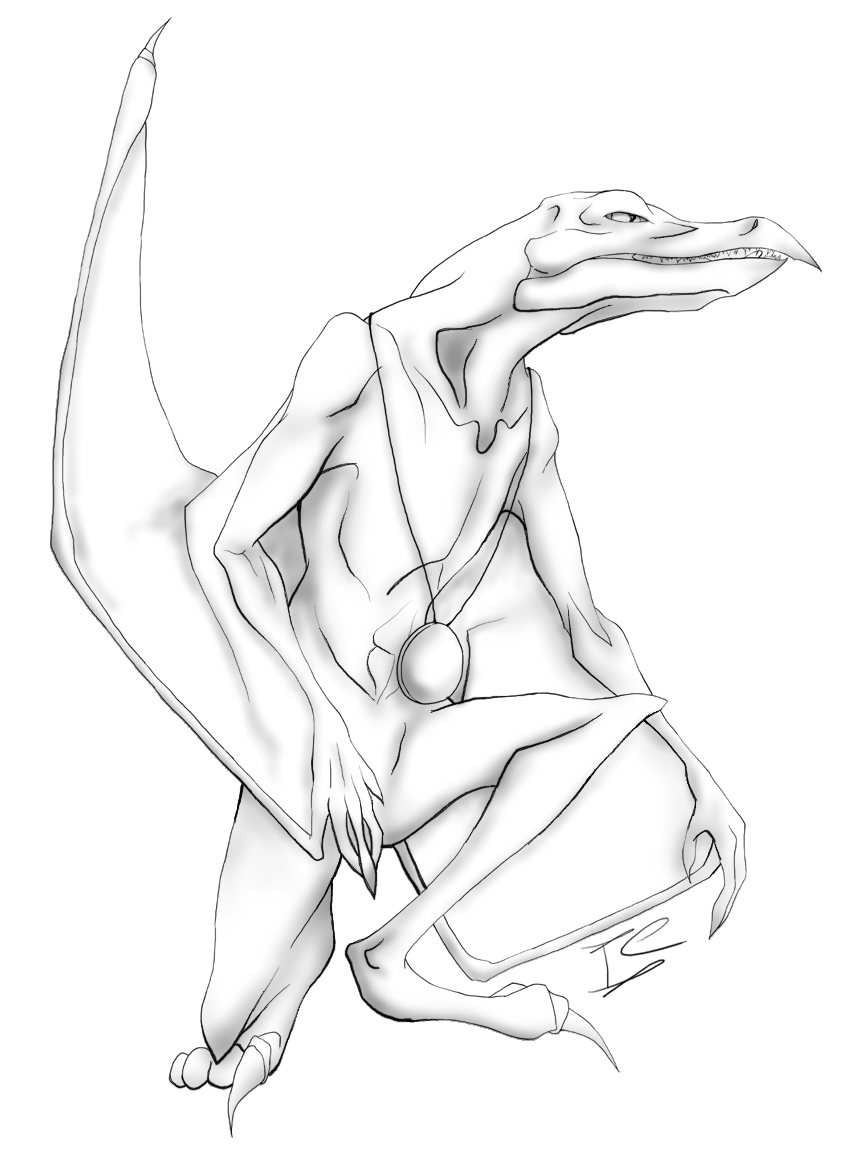
Descended from sentient rhamphorhynchoid pterosaur, the advancements of pteryx culture rivaled those of Blackmoor at its height, 7,500 years before Blackmoor was even founded. Just as their last city on the outer world was about to fall to the carnifex, they were transported to the Hollow Moon, falsely believing that their enemies trapped them in a small pocket universe. Since then the pteryx have become slightly paranoid and are determined to prevent similar tragedies from befalling them in the future.
A telepathic species, the pteryx prefer to spend their time in esoteric pursuits of art, literature, and scholarly studies. Unfortunately for most other races in the Hollow Moon, the pteryx have a very narrow definition for sentience (thanks in part to a curse placed upon them by Demogorgon before the Spell of Remembrance was cast), only considering other telepathic species to be sentient (which in Matera includes the Hsiao, kopru, and - thanks to their ability to communicate nonverbally through smell - the troglodytes). All other species are considered to be no more than animals. It is because of this attitude, and a deep seated fear that no other species on the planet - sentient or not - should ever threaten the pteryx as the carnifex once did, that the pteryx undergo periodic culling operations. This happens rarely (about once every 800 years or so), but when it does, the results are devastating.
Pteryx cities are artificially crafted stalactites hung from the ceilings of volcanic caverns. The only way to attain access is by fight. Many such cities also have amenities built in for the pteryx’s bipedal servants - the troglodytes - who have been serving the pteryx since before being transported to the Hollow Moon.
Fire Times
Fire times in the Pteryx Apennines are quite mild, as over the millenia, the pteryx have learned how to harness and divert the geothermal energy in the region. Some rumors persist that if attacked, the pteryx could even direct the raw volcanic power in the area as a weapon - dousing their enemies in molten rock. None in the Hollow Moon have yet been insane enough to put this rumor to the test.
Adventure Ideas
PCs stumble upon a wounded pteryx and must decide whether or not to help the creature. The accident was staged by Demogorgon (or one of her servants) to precipitate another pteryx culling. Should the PCs fail to help the wounded pteryx, or should they be blamed for its condition, the nearby races of the Hollow Moon may pay the ultimate price.
Folks have been disappearing recently and the populace blames a mysterious shadowy figure often seen in the vicinity. In fact a pteryx scientist has been swooping down from the sky to collect “samples” for study. The PCs will have to discover its layer and release any captives before the creature decides to return to the Apennines and its captives are lost forever.
The pteryx are growing restless again, and several of the nearby Hollow Moon races have banded together in the hopes of finding a way to prevent another culling. The PCs must set out on an epic quest to find the ancient carnifex artifact that Demogorgon used to curse her people. Once the artifact is destroyed, and the curse is broken, the pteryx may finally come to realize that their neighbors are more than mere animalis.
Images
[This section for use by layout]
https://docs.google.com/file/d/0BxbFl59TcUwLLXdkV21UV0xzczg/edit?usp=sharing, Once in a Blue Moon article header
https://docs.google.com/file/d/0BxbFl59TcUwLTFVVN1BSVXdmbXc/edit?usp=sharing, Lunar Regions, “Figure 1: Cross section of Matera’s interior showing major geographical regions.”
https://docs.google.com/file/d/0BxbFl59TcUwLa19zRmZTTHh3Zms/edit?usp=sharing, Lunar Directions, “Figure 2: Nearside hemisphere showing Matera’s cardinal directions.”
https://docs.google.com/file/d/0BxbFl59TcUwLRHM0RHBXVHBtVkU/edit?usp=sharing, Lunar Lighting, “Figure 3: Cross section of Matera’s interior showing light progression throughout the lunar day.”
https://docs.google.com/file/d/0BxbFl59TcUwLcXdQbUxZd1EtMjA/edit?usp=sharing, Lunar Time, “Figure 4: Cross section of Matera’s interior showing segments of the lunar day.”
https://docs.google.com/file/d/0BxbFl59TcUwLaWRVVGNkUG44OFk/edit?usp=sharing, Hollow Moon at 40 mph (by John Calvin), “Map of the Hollow Moon at 40 mph.” Used by permission of the author.
https://docs.google.com/file/d/0BxbFl59TcUwLS29LM1IxZVViUXc/edit?usp=sharing, Cryion shaman (by I. Calvin), Used by permission of the author.
https://docs.google.com/file/d/0BxbFl59TcUwLZWRTSXV0aXpPVms/edit?usp=sharing, Desert ghost (by I. Calvin), Used by permission of the author.
https://docs.google.com/file/d/0BxbFl59TcUwLcE5zQk91VVRRZkk/edit?usp=sharing, Young pteryx scion (by I. Calvin), Used by permission of the author.
References
[This section for use by layout]
Hollow Moon Planetology: Blue Moon - Lunar Geography (by Sharon Dornhoff)
Hollow Moon Planetology: Blue Moon - Lighting Conditions (by Sharon Dornhoff)
Hollow Moon Planetology: Blue Moon - Calendar (by Sharon Dornhoff)
Hollow Moon Planetology: Blue Moon - Eclipses (by Sharon Dornhoff)
Hollow Moon Planetology: Blue Moon - Seas & Tides (by Sharon Dornhoff)
Hollow Moon Planetology: Blue Moon - Climate & Weather (by Sharon Dornhoff)
Hollow Moon Planetology: Blue Moon - Natural Disasters (by Sharon Dornhoff)
The Spell of Remembrance: Recursive history (by Sharon Dornhoff)
Hollow Moon Exploration: A Brief History of Space (Travel) (by Sharon Dornhoff)
Hollow Moon Planetology: Blue Moon - Emergence (by Sharon Dornhoff)
Hollow Moon Cultures (by Sharon Dornhoff)
[Hollow Moon] Ruminations Over a Blue Moon (thread on The Piazza)
Background on Hollow Moon Magic (by Sharon Dornhoff)
Materan Spells (by Sharon Dornhoff)
Hollow Moon Planetology: Blue Moon - Animal Life (by Sharon Dornhoff)
Hollow Moon Cultures: Pteryx of the Apennines (by Sharon Dornhoff)
